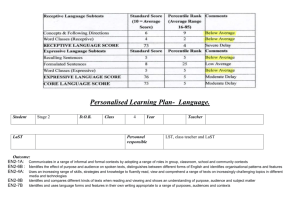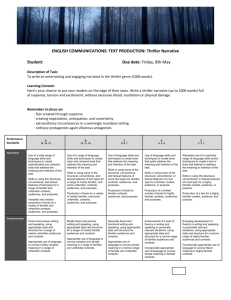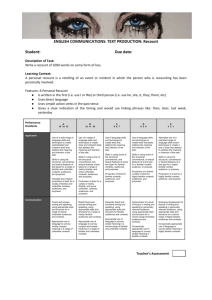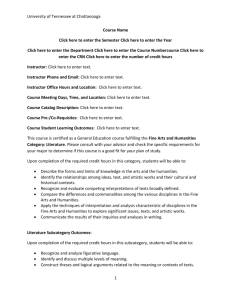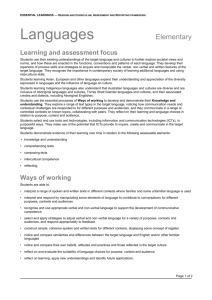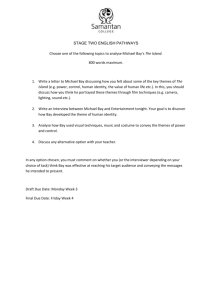Task Sheet
advertisement
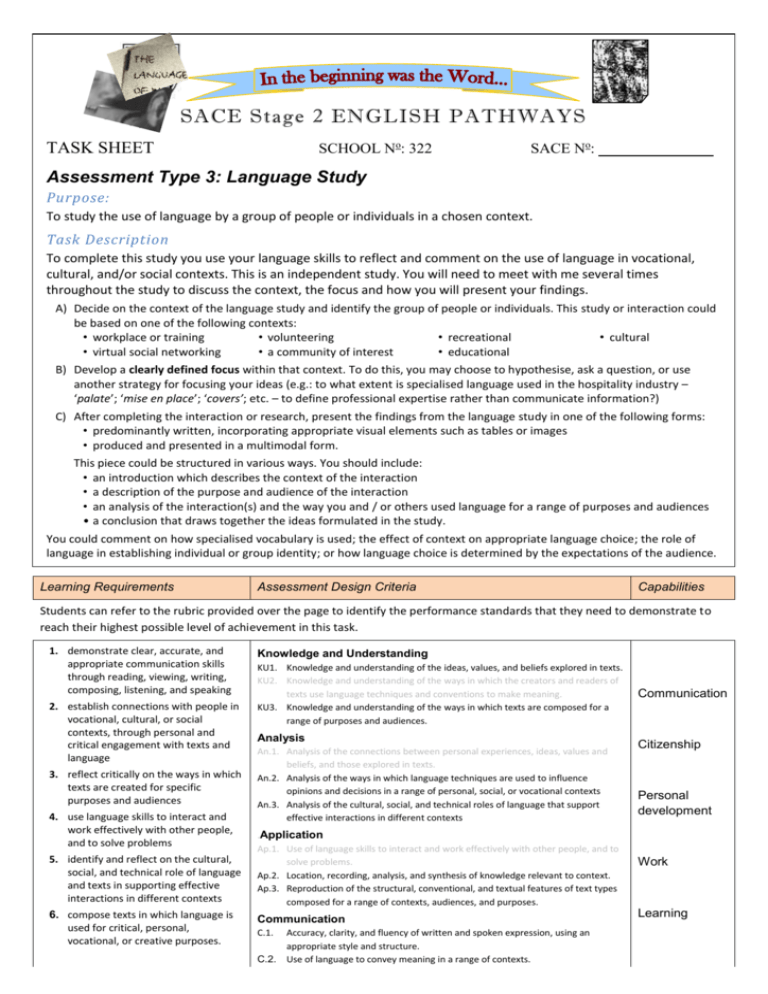
SACE Stage 2 ENGLISH PATHWAYS SCHOOL No: 322 TASK SHEET SACE No: Assessment Type 3: Language Study Purpose: To study the use of language by a group of people or individuals in a chosen context. Task Description To complete this study you use your language skills to reflect and comment on the use of language in vocational, cultural, and/or social contexts. This is an independent study. You will need to meet with me several times throughout the study to discuss the context, the focus and how you will present your findings. A) Decide on the context of the language study and identify the group of people or individuals. This study or interaction could be based on one of the following contexts: • workplace or training • volunteering • recreational • cultural • virtual social networking • a community of interest • educational B) Develop a clearly defined focus within that context. To do this, you may choose to hypothesise, ask a question, or use another strategy for focusing your ideas (e.g.: to what extent is specialised language used in the hospitality industry – ‘palate’; ‘mise en place’; ‘covers’; etc. – to define professional expertise rather than communicate information?) C) After completing the interaction or research, present the findings from the language study in one of the following forms: • predominantly written, incorporating appropriate visual elements such as tables or images • produced and presented in a multimodal form. This piece could be structured in various ways. You should include: • an introduction which describes the context of the interaction • a description of the purpose and audience of the interaction • an analysis of the interaction(s) and the way you and / or others used language for a range of purposes and audiences • a conclusion that draws together the ideas formulated in the study. You could comment on how specialised vocabulary is used; the effect of context on appropriate language choice; the role of language in establishing individual or group identity; or how language choice is determined by the expectations of the audience. Learning Requirements Assessment Design Criteria Capabilities Students can refer to the rubric provided over the page to identify the performance standards that they need to demonstrate to reach their highest possible level of achievement in this task. 1. demonstrate clear, accurate, and appropriate communication skills through reading, viewing, writing, composing, listening, and speaking 2. establish connections with people in vocational, cultural, or social contexts, through personal and critical engagement with texts and language 3. reflect critically on the ways in which texts are created for specific purposes and audiences 4. use language skills to interact and work effectively with other people, and to solve problems 5. identify and reflect on the cultural, social, and technical role of language and texts in supporting effective interactions in different contexts 6. compose texts in which language is used for critical, personal, vocational, or creative purposes. Knowledge and Understanding KU1. Knowledge and understanding of the ideas, values, and beliefs explored in texts. KU2. Knowledge and understanding of the ways in which the creators and readers of texts use language techniques and conventions to make meaning. KU3. Knowledge and understanding of the ways in which texts are composed for a range of purposes and audiences. Analysis An.1. Analysis of the connections between personal experiences, ideas, values and beliefs, and those explored in texts. An.2. Analysis of the ways in which language techniques are used to influence opinions and decisions in a range of personal, social, or vocational contexts An.3. Analysis of the cultural, social, and technical roles of language that support effective interactions in different contexts .Application Ap.1. Use of language skills to interact and work effectively with other people, and to solve problems. Ap.2. Location, recording, analysis, and synthesis of knowledge relevant to context. Ap.3. Reproduction of the structural, conventional, and textual features of text types composed for a range of contexts, audiences, and purposes. Communication C.1. Accuracy, clarity, and fluency of written and spoken expression, using an appropriate style and structure. C.2. Use of language to convey meaning in a range of contexts. Communication Citizenship Personal development Work Learning A Knowledge and Understanding Analysis Application Communication Detailed knowledge and understanding of the ideas, values, and beliefs in familiar and unfamiliar texts. Detailed analysis of complex connections between personal experiences, ideas, values and beliefs, and those explored in familiar and unfamiliar texts. Use of a comprehensive range of language skills to interact effectively in different contexts, and to analyse and solve simple and complex problems. Perceptive analysis of a range of ways in which authors use language techniques to influence opinions and decisions in familiar and unfamiliar texts. Location, recording, analysis, and synthesis of knowledge relevant to familiar and unfamiliar contexts. Fluent and precise writing and speaking, using an appropriate style and structure for a range of mainly unfamiliar audiences and contexts. 15 Knowledge and understanding of the 14 13 B ways in which the creators and readers of familiar and unfamiliar texts use a range of language techniques to make meaning. Comprehensive knowledge and understanding of the ways in which familiar and unfamiliar texts are composed for a range of purposes and audiences. Perceptive analysis of aspects of familiar and unfamiliar cultural, social, and technical roles of language that support effective interactions in different contexts. Sophisticated skills in reproducing the structural, conventional, and textual features of text types for a range of familiar and unfamiliar contexts, audiences, and purposes. Sound knowledge and understanding of some ideas, values, and beliefs in familiar, and some unfamiliar, texts. Analysis of some complex connections between personal experiences, ideas, values and beliefs, and those explored in familiar, and some unfamiliar, texts. Use of a sound range of language skills to interact effectively in different contexts, and to solve simple and complex problems. ways in which the creators and readers of mainly familiar texts use some language techniques to make meaning. Well-considered analysis of a range of ways in which authors use language techniques to influence opinions and decisions in familiar, and some unfamiliar, texts. Location, recording, analysis, and occasional synthesis of knowledge relevant to mostly familiar contexts. Mostly fluent and precise writing and speaking, using an appropriate style and structure for a range of mostly familiar audiences and contexts. Well-considered analysis of aspects of mainly familiar, and some unfamiliar, cultural, social, or technical roles of language that support effective interactions in different contexts. Sound skills in reproducing some of the structural, conventional, and textual features of text types for a range of mainly familiar, and some unfamiliar, contexts, audiences, and purposes. Appropriate use of language to convey complex and simple meaning in a range of familiar, and some unfamiliar, contexts. Competent analysis of simple connections between personal experiences, ideas, values or beliefs and those explored in familiar texts. Use of competent language skills to interact effectively in different contexts, and to solve routine problems in familiar contexts. Descriptive analysis of a number of ways in which authors use language techniques to influence opinions and decisions in familiar texts. Location, recording, and occasional analysis of knowledge relevant to a familiar context. Generally clear and accurate writing and speaking, using an appropriate style and structure for familiar audiences and contexts. 12 Knowledge and understanding of the 11 10 Sound knowledge and understanding of the ways in which mainly familiar texts are composed for some purposes and audiences. C Knowledge and understanding of some ideas, values, or beliefs in familiar texts. 9 Knowledge and understanding of the ways in which the creators and readers of a narrow range of familiar texts use some language techniques to make meaning. 8 7 Knowledge and understanding of the ways in which familiar texts are composed for familiar purposes and audiences. D Identification of some simple ideas, values, or beliefs in some familiar texts. 6 Knowledge and understanding of the ways in which the creators and readers of a narrow range of familiar texts use a restricted range of language techniques to make simple or factual meaning. 5 4 Knowledge of the ways in which familiar texts are composed for personally relevant purposes and familiar audiences. E Identification of a simple idea, value, or belief in a familiar text. 3 Some knowledge and emerging understanding of the way in which a creator or reader of a highly familiar text uses a language technique to make factual meaning. 2 1 Appropriate use of language to convey mostly complex meaning in a range of familiar and unfamiliar contexts. Some knowledge of the ways in which highly familiar texts are composed for personally relevant purposes and highly familiar audiences. Skills in reproducing some of the structural, conventional, and textual features of some text types for familiar contexts, audiences, and purposes. Appropriate use of language to convey simple meaning in a narrow range of familiar and unfamiliar contexts. Reference to simple connections between uncomplicated personal experiences, ideas, values or beliefs, and those explored in familiar texts. Use of a restricted range of language skills to interact in familiar contexts, and to solve simple problems. Reference to some ways in which authors use a narrow range of language techniques to influence opinions and decisions in familiar texts. Location and recording of factual knowledge relevant to a familiar context. A level of fluency in writing and speaking in personally relevant situations, using an appropriate style and structure for a narrow range of familiar audiences and contexts. Competent analysis of some aspects of mainly familiar cultural, social, or technical roles of language that support effective interactions in different contexts. Reference to some simple aspects of familiar cultural, social, or technical roles of language that support effective interactions in one or more contexts. Limited skills in reproducing some of the structural, conventional, or textual features of a text type for a familiar context, audience, or purpose. Recognition of a simple connection between a straightforward personal experience, idea, value or belief, and that explored in a highly familiar text. Use of a restricted range of language skills to interact in highly familiar contexts, and to solve simple problems. Reference to the way in which an author uses language techniques to influence opinions and decisions in a highly familiar text. Location or recording of factual knowledge relevant to a highly familiar context. Recognition of some simple aspects of highly familiar cultural, social, or technical roles of language that support effective interactions in one or more contexts. Restricted skills in reproducing a limited number of structural, conventional, or textual features of a text type for a highly familiar context, audience, or purpose. Occasionally appropriate use of language to convey simple meaning in familiar contexts. Emerging development of fluency in writing and speaking in personally relevant situations, using an appropriate style and structure for a narrow range of highly familiar audiences and contexts. Occasionally appropriate use of language to convey literal meaning in highly familiar contexts.

